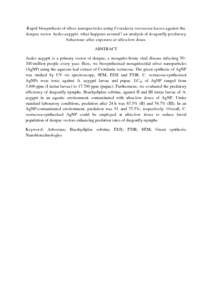Citation
Murugan, Kadarkarai and Sanoopaa, C. P. and Madhiyazhagana, Pari and Dinesh, Devakumar and Subramaniam, Jayapal and Panneerselvama, Chellasamy and Roni, Mathath and Suresh, Udaiyan and Nicoletti, Marcello and Alarfaj, Abdullah A. and Murugan, Alwarkurichi Munusamy and Higuchi, Akon and Kumar, Suresh S. and Perumalsamy, Haribalan and Ahn, Yoong Joon and Benelli, Giovanni
(2016)
Rapid biosynthesis of silver nanopeprintss using Crotalaria verrucosa leaves against the dengue vector Aedes aegypti: what happens around? An analysis of dragonfly predatory behaviour after exposure at ultra-low doses.
Natural Product Research, 30 (7).
826 - 833.
ISSN 1478-6419; ESSN: 1478-6427
Abstract
Aedes aegypti is a primary vector of dengue, a mosquito-borne viral disease infecting 50–100 million people every year. Here, we biosynthesised mosquitocidal silver nanoparticles (AgNP) using the aqueous leaf extract of Crotalaria verrucosa. The green synthesis of AgNP was studied by UV–vis spectroscopy, SEM, EDX and FTIR. C. verrucosa-synthesised AgNPs were toxic against A. aegypti larvae and pupae. LC50 of AgNP ranged from 3.496 ppm (I instar larvae) to 17.700 ppm (pupae). Furthermore, we evaluated the predatory efficiency of dragonfly nymphs, Brachydiplax sobrina, against II and III instar larvae of A. aegypti in an aquatic environment contaminated with ultra-low doses of AgNP. Under standard laboratory conditions, predation after 24 h was 87.5% (II) and 54.7% (III). In an AgNP-contaminated environment, predation was 91 and 75.5%, respectively. Overall, C. verrucosa-synthesised AgNP could be employed at ultra-low doses to reduce larval population of dengue vectors enhancing predation rates of dragonfly nymphs.
Download File
![[img]](http://psasir.upm.edu.my/53724/1.hassmallThumbnailVersion/Rapid%20biosynthesis%20of%20silver%20nanoparticles%20using%20Crotalaria%20verrucosa%20leaves%20.pdf)  Preview |
|
PDF
Rapid biosynthesis of silver nanoparticles using Crotalaria verrucosa leaves .pdf
Download (74kB)
| Preview
|
|
Additional Metadata
Actions (login required)
 |
View Item |

